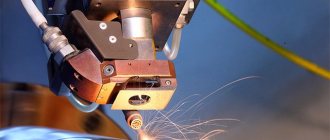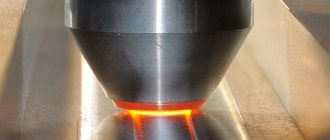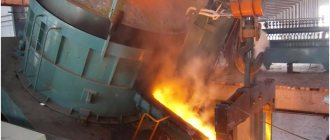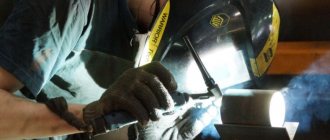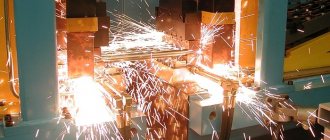The process of steel deoxidation is very complex. It is usually described as a mechanism of four sequential steps. 1) Dissolution and homogenization of the deoxidizer in the steel melt in order to direct the deoxidation reaction towards the formation of oxides. 2) Stimulating the formation of critical nuclei of deoxidation products in a homogeneous environment. 3) Carrying out the actual deoxidation by increasing the amount of reaction products. 4) Separation of deoxidation reaction products by flotation from the melt in order to increase the purity of steel.
Steel deoxidation
The high concentration of oxygen dissolved in steel (increased oxygen activity), obtained after the end of the oxidation processes, does not make it possible to obtain a high-quality ingot, since a decrease in the temperature of the metal during the crystallization process leads to the resumption of the carbon oxidation reaction [C] + [O] → CO gas and the formation of gas bubbles, which, as a rule, remain in the ingot and are not always welded during pressure treatment. Oxygen unused during this reaction is released from the metal melt at the end of crystallization in the form of films of iron oxide FeO along the grain boundaries and sharply worsens the mechanical properties of steel. This necessitates metal deoxidation. Deoxidation is a technological operation that leads to a decrease in the concentration of dissolved oxygen (or oxygen activity) in steel to the limits that ensure the required quality of the finished metal. The dissolved oxygen content of the metal can be reduced either by reducing the total oxygen content or by binding the dissolved oxygen into strong compounds that are insoluble in the steel. The following methods of steel deoxidation are known: precipitation (previously not quite accurately called deep) deoxidation; extraction, or diffusion, deoxidation (deoxidation by slag); deoxidation by vacuum treatment and electrochemical deoxidation. In steelmaking practice, the first two methods are used; recently, deoxidation by vacuum treatment has also been increasingly used.
During precipitation deoxidation, deoxidizing elements that have a greater chemical affinity for oxygen than iron are introduced into the metal melt. As a result of the reaction between dissolved oxygen and the deoxidizing agent, an oxide that is practically insoluble in iron is formed, the density of which is less than the density of liquid steel, i.e., dissolved oxygen is converted into an insoluble oxide and a kind of “precipitate” of insoluble oxides is formed in the melt. The resulting “precipitate” floats or is otherwise removed into the slag. Hence the name of the method – precipitating deoxidation. Since deoxidizers are usually introduced (or attempted to be introduced) deep into the metal melt, this deoxidation method is sometimes called deep deoxidation. In general, precipitation deoxidation can be represented by the following diagram:
m[R] + n[O] = (RmOn),
where R is the deoxidizer element.
In metallurgical practice, for the precipitation deoxidation of steel, manganese in the form of ferromanganese, silicon in the form of ferrosilicon, aluminum, and carbon in various forms are most often used (as the cheapest and most accessible). Sometimes more expensive alloys of alkaline earth metals (usually calcium) and rare earth metals (with a predominance of cerium) are used to deoxidize steel. All deoxidation reactions with such deoxidizers occur with the release of heat, so the depth of the deoxidation reaction increases with decreasing temperature (the equilibrium of the deoxidation reaction shifts to the right, towards the formation of an additional amount of deoxidizer oxide). Oxides of deoxidizing elements formed during the deoxidation process are usually called deoxidation products in the domestic specialized literature. Deoxidation products formed in liquid metal during the deoxidation process are usually called primary deoxidation products. Throughout the existence of scientifically based steelmaking technologies, specialists have strived to carry out precipitation deoxidation so that the primary deoxidation products are removed from the metal as completely and as quickly as possible. Many studies have been devoted to this problem, the results of which have allowed metallurgists to quickly and almost completely remove primary deoxidation products from metal. But during the process of steel crystallization, as the temperature decreases, the precipitation deoxidation reactions continue to occur, while “new” (secondary) deoxidation products are formed, which practically cannot be removed from the crystallizing very viscous metal and remain in the steel. Therefore, after precipitation deoxidation, the finished steel always contains a certain amount of non-metallic inclusions - deoxidation products, which is the main disadvantage of this deoxidation method. But due to the simplicity of the operation and the high rate of removal of dissolved oxygen from the metal, precipitation deoxidation remains the main method of steel deoxidation.
To reduce the amount and size of secondary (crystallization) deoxidation products, it is very important to reduce the concentration of dissolved oxygen during deoxidation of liquid metal to the lowest possible values. The residual concentration of dissolved oxygen in the metal depends on the temperature, the concentration of the deoxidizing element and the deoxidizing ability of the deoxidizing element. The deoxidizing ability of a deoxidizing element is usually called the concentration of dissolved oxygen [O]p (or oxygen activity a[O]), corresponding to the specific concentration of the deoxidizing element at which it is in equilibrium with oxygen at a given temperature. Data on the deoxidizing ability of various deoxidizers are obtained in laboratory studies, since under production conditions it is not possible to achieve equilibrium in deoxidation reactions. Typically, the comparison of the deoxidizing ability of deoxidizers is carried out at a temperature of 1600 °C. For practical needs, it is most convenient to use data on the deoxidizing capacity, presented graphically in the coordinates [O]p - [R] or a[O] - [R], lga[O], etc. It should be noted that data on the deoxidizing ability of certain deoxidizers obtained from different studies often differ greatly. This is explained by the fact that different equipment and different research methods are used; as well as different initial concentrations of dissolved oxygen and different compositions of deoxidation products.
Oxygen is a constant companion of iron and steel. The maximum solubility of oxygen in liquid steel at its melting temperature does not exceed 0.22%. With increasing temperature, the solubility of oxygen in liquid steel increases. Oxygen in steel is partially in the form of a solution, entering mainly into the composition of non-metallic inclusions: oxides - FeO, MnO, SiO2, Al2O3, CaO and a number of their compounds with each other and sulfur (the so-called silicates, aluminates, spinels, oxysulfides, etc. .).
Oxygen worsens the mechanical properties of steel, reduces its impact strength at low temperatures, reduces tensile strength (tensile strength), and increases the heterogeneity of the metal. Combined oxygen and sulfur compounds form low-melting non-metallic inclusions located along the grain boundaries. During pressure treatment (rolling or forging) in such a metal at high temperatures, the formation of cracks and flaws (the phenomenon of red brittleness) is possible.
The shape, quantity and composition of oxygen inclusions in the finished steel depend on the methods of metal deoxidation, out-of-furnace processing, casting and solidification conditions of the melt, as well as on the nature of the steel smelting processes (basic or acid). Steel deoxidation is carried out in such a way as to reduce the content of oxygen and non-metallic inclusions in it and reduce their harmful effect on the quality of the metal. For this purpose, the following methods of steel deoxidation are used: diffusion - exposure of the metal to slag with a low content of iron oxides; sedimentary—exposure to metal directly by deoxidizing elements; combined - simultaneous exposure of metal to slag and deoxidizing elements.
At equilibrium, the ratio of the oxygen content in iron [O] to the iron monoxide content in the slag (FeO) is a constant value and depends on the basicity of the slag and temperature. With a slag basicity of 2 and a temperature of 1600 °C, this ratio is 0.005. If the (FeO) content in the slag is below equilibrium, then the transition of oxygen in the form of FeO from the metal to the slag is ensured. In other words, by treating the bath with iron-free slag, you can reduce the oxygen content in the metal.
Addition of powdered materials to the furnace - coke, ferrosilicon, aluminum - ensures the interaction of deoxidizing elements with (FeO) of the slag and reducing its concentration below 0.5%. If the final content of (FeO) in the slag is 0.5%, then the final oxygen content in the metal under equilibrium conditions, determined from the ratio [O]con/0.5 = 0.005, will be: [0]con = 0.0025%.
In practice, equilibrium between the slag and metal during the recovery period of smelting (finishing) is not achieved and the oxygen content in the metal before release from the electric furnace fluctuates between 0.003-0.012%. In this case, the decrease in oxygen content in the metal occurs mainly due to the diffusion of oxygen from the metal into the slag, therefore this deoxidation method is called diffusion. Diffusion deoxidation of a metal bath occurs when steel is smelted in arc furnaces with a capacity of up to 25 tons. The process is carried out under “white” * (gray) or carbide slag. White slag is produced by deoxidizing the main slag with coke, and then with ferrosilicon and aluminum powders. Carbide - as a result of intensive deoxidation of lime slag with coke powder.
Modern heavy-duty arc furnaces are equipped with high-performance units for exhaust gas extraction and purification, which during operation create intense gas exchange in the working space.
Taking this into account, reduction slag of the required composition, consistency and deoxidation is placed in a liquid bath in the furnace 15-20 minutes before the melt is released into the ladle by intensively adding coke, ferrosilicon and aluminum powders. The metal finishing period (adjusting the chemical composition of the steel, heating the metal, etc.) is carried out for a minimum time under lime slag with a basicity of 3-4.
The diffusion method of metal refining makes it possible to significantly reduce the contamination of steel with deoxidation products - non-metallic inclusions, since the interaction occurs in the slag and at the metal-slag interface. However, the process is inefficient. The formation of a reducing base slag by the time the smelt is released from a heavy-duty furnace can significantly increase the efficiency of phase interaction at the time of draining the slag and metal and thereby ensure a high degree of refining of steel from oxygen and sulfur.
Deoxidation of steel by directly introducing deoxidizers into the liquid metal in the form of pieces or powder is called deep or sedimentary. It occurs in the metal at different depths depending on the specific gravity of the deoxidizer material, the size of its pieces and the method of introduction into the metal. The effect of sedimentary deoxidation of the metal increases with a decrease in the melting temperature of deoxidizing substances and with an increase in their solubility in iron. The combination of processes of sedimentary deoxidation of metal with the diffusion interaction of deoxidizing elements with oxygen is classified as combined methods.
Classification of carbon steels by degree of deoxidation
Calm
Such alloys have the most uniform structure. For deoxidation, aluminum, ferrosilicon and ferromanganese are used, which almost completely remove the gases present in the melt. The combination of the almost complete absence of gases with a fine-grained structure due to the presence of residual aluminum ensures good quality of the metal. These grades are suitable for the manufacture of parts, products and structures for critical purposes. The main disadvantage is the high cost.
Boiling
This is the cheapest and least quality group. Due to the use of a minimal amount of additives for deoxidation, dissolved gases are present in the material, which cause heterogeneity in the structure, chemical composition, and therefore mechanical properties. Such metals have poor weldability, since due to the presence of gases there is a high probability of cracks forming at the seams.
Semi-calm
The group occupies an intermediate position in terms of cost and characteristics. Much fewer gas bubbles form in the casting compared to boiling steels. When rolling, internal defects in the bulk are eliminated. Such materials are often used as structural alloys.
Methods for metal deoxidation
During the recovery period of electric smelting, the deoxidation of the metal is carried out by the diffusion method, in which the deoxidation reaction, i.e., the binding of oxygen into strong oxides, occurs not in the metal, but in the slag, and the metal, therefore, is not contaminated with deoxidation products. This is the main advantage of diffusion deoxidation over deep deoxidation. Another advantage of diffusion deoxidation is the weaker development of the metal oxidation reaction by slag during and after the metal is released from the furnace. This, in particular, explains the insignificant waste of alloying elements and deoxidizers in electric furnaces,
The disadvantages of diffusion deoxidation include:
- reduction in furnace productivity;
- reduction in the resistance of slopes and bottoms, especially during deoxidation of slag with silicon, since the resulting silica interacts with the main lining;
- recovery of phosphorus from slag into metal, which necessitates careful removal of oxidative slag;
- increased consumption of deoxidizers and the need to grind them;
- the difficulty of sealing furnaces (especially large ones) to prevent air leaks.
Despite the noted disadvantages of diffusion deoxidation, its advantages associated with the ability to obtain well-deoxidized metal with a low content of sulfur and non-metallic inclusions are so obvious in the production of high-quality and high-quality steel that this method is widely used in steel smelting in electric furnaces.
However, to reduce the negative impact of diffusion deoxidation of metal, a technology combining the advantages of diffusion and deep deoxidation has recently become widespread. In this case, before the start of diffusion deoxidation, lump deoxidizers are added to the metal: ferromanganese, ferrosilicon, aluminum, etc.
Sometimes deep deoxidation is used for the final deoxidation of metal.
For diffusion deoxidation of metal, carbon is widely used, which is applied to the slag most often in the form of coke or electrode waste. With a sufficiently large consumption of coke or electrode scrap and a high CaO content in the slag in the arc zone under the electrodes, calcium carbide is formed by the reaction
(CaO) + 3CT = (CaC2) + {CO}.
Calcium carbide, having a high affinity for oxygen, interacts with slag iron oxides:
(CaC2) + 3(FeO) = 3[Fe] + 2{CO} + (CaO).
Under carbide slag (>2% CaCr), the FeO content in the slag can be reduced to 0.5%, which corresponds to an equilibrium oxygen content in the metal of 0.0012% in the metal at 1600° C. Such an oxygen content in the metal cannot be achieved even at 0.3% Ti. A feature of carbon as a deoxidizer is the small effect of temperature on its affinity for oxygen. The relative cheapness of coke and electrode scrap and their good deoxidation effect explain their widespread use for diffusion deoxidation of slag.
Depending on the content of calcium carbide in the slag, and therefore the degree of its deoxidation, the slag of the reduction period is divided into white (up to 2% CaC2) and carbide (>2% CaC2). Structural steels with a carbon content below 0.35% are smelted under white slag; medium- and high-carbon steels are smelted under carbide slag.
Sometimes metal refining during the oxidation period is carried out under lime-alumina, lime-chamotte or magnesia-alumina slag.
Carbon steel - classification, marking and application
Steel is an alloy consisting of two essential components - iron and carbon. Additional elements: silicon less than 1%, manganese less than 1%, sulfur less than 0.05%, phosphorus less than 0.06%. Carbon content no more than 2.14%. Alloys with a C percentage greater than 2.14% are classified as cast iron. Based on their chemical composition, steel grades are divided into carbon and alloy, which contain additional additives that give the material the desired characteristics. Carbon steel alloys are classified according to the degree of deoxidation, carbon content, and quality.
Diffusion deoxidation under white slag
After downloading the oxidizing slag, slag from lime and fluorspar is added to the bath in a ratio of 3:2 and in an amount of 2-4% by weight of the metal. Liquid-mobile slag is formed in 10-15 minutes and a reducing mixture of lime, fluorspar and ground sifted coke or charcoal with a particle size of no more than 0.5-1.0 mm is added to it in a ratio of 8:2:1.
As a result of deoxidation of the slag by coke carbon, the FeO content in it decreases to 1.5% after about 40 minutes, and the slag sample, after cooling, takes on a gray cyst instead of a black one at the beginning of the reduction period, when the slag contains relatively many iron oxides.
Due to the possibility of carburization of the metal, its further deoxidation is carried out with silicon. Finely ground ferrosilicon of the FS45 and FS75 grades is introduced into the slag mixture. The composition of the slag mixture is as follows: four parts lime, one part fluorspar, one part coke and one part ferrosilicon. Slag deoxidation with silicon lasts ~20 minutes. About 50% of the Si introduced from the slag by ferrosilicon is absorbed by the metal.
Slag deoxidation with silicon is sometimes carried out from the beginning of the reduction period, which eliminates carburization of the metal. However, the silicon content in the metal increases, it reacts with oxygen dissolved in the metal, and the resulting deoxidation products partially remain in the metal. Therefore, metal contamination with non-metallic inclusions may increase with this technology.
White slag usually has the following composition: 55-65% CaO, 10-20% SiO2, up to 1% FeO, 0.4% MnO, 12-16% MgO, 2-3% Al2O3, 5-10% CaF2, 1% CaS , up to 2% CaC2. A white slag sample crumbles upon cooling, which is due to the presence of calcium silicate 2 CaO • SiO2 in it, which at 675° C changes its modification, increasing in volume.
To obtain a relatively deoxidized metal, it is necessary to keep the metal under white slag for ~ 1 hour, periodically adding a certain amount of deoxidizing mixture with coke or ferrosilicon. Good white slag foams in the furnace; thick slag makes it difficult to heat the metal and diffusion processes. Therefore, it is necessary to continuously maintain the normal consistency of the slag by promptly increasing the amount of fluorspar in the mixture.
Sometimes an increase in slag viscosity is caused by an increase in the MgO content in the slag as a result of the destruction of slopes and bottoms. In this case, the slag must be downloaded and a new one created. Liquid slag is corrected with a lime additive.
Diffusion deoxidation under carbide slag
When carrying out the recovery period under carbide slag, the metal is first covered with a slag mixture of the same composition as during deoxidation under white slag. After the formation of a uniform layer of liquid slag, a mixture of lime, fluorspar and ground coke is fed into the furnace in a ratio of 3:1:1. The total amount of slag during the recovery period is 4% in large-capacity electric furnaces and 7-8% in small-capacity furnaces (by weight of metal).
Calcium carbide is formed in the arc zone with high heat absorption, so the furnace is well compacted and increased power is supplied to it. The oven is not opened for 20-30 minutes. An external sign of the formation of carbide slag is black smoke escaping from under the dampers.
Calcium carbide from the arc zone is spread throughout the entire slag volume. It is a strong deoxidizing agent, interacting with FeO according to the reaction (CaC2) + 3(FeO) = 3[Fe] + 2{CO} + (CaO). Calcium carbide partially reduces silicon from slag silicon oxide. Therefore, in the process of deoxidation of metal with carbide slag, the silicon content in the metal increases by 0.05–0.1%. Carbide slag sticks tightly to the spoon, and when the slagged tool is soaked in water, a specific smell of acetylene is felt.
Deoxidation under the carbide slag continues for at least 1 hour. To maintain the required content of calcium carbide in the slag, ground coke with lime and fluorspar is periodically added to the furnace if it is necessary to reduce the viscosity of the slag.
A significant disadvantage of smelting under carbide slag is the noticeable carburization of the metal in the furnace and during tapping, as well as the adhesion of the carbide slag to the metal, which sometimes leads to the appearance of relatively large slag inclusions in the finished metal. To eliminate this phenomenon, the carbide slag is converted to white approximately 30 minutes before release. To do this, lime with fluorspar is added to the furnace, which increases the total amount of slag and reduces the content of calcium carbide in it. Sometimes the working window is additionally opened, thus promoting the oxidation of calcium carbide. If after this the slag remains carbide, then part of the slag (∼1/3) is removed from the furnace and a slag mixture of lime, fluorspar and fireclay is thrown into the furnace.
Carbide slag has the following chemical composition: 55-65% CaO, 10-15% SiO2, up to 0.5% FeO, up to 0.3% MnO, 6-10% MgO, 2-3% Al2O3, 1-2% CaS , 2—4% CaC2, 8—12% CaF2.
The main difference between carbide slag and white slag in composition is the slightly lower content of iron and manganese oxides in the first slag, as well as the increased content of calcium carbide.
Types of unalloyed carbon steels by carbon content
Low carbon with a C content of no more than 0.25%
Most of these products are produced in the form of cold-rolled or annealed sheets and strips. Properties, and therefore the scope of its application, depend on the percentage of components:
- Up to 0.1% C, Mn less than 0.4%. High ability to hot deformation and cold drawing. The materials are in demand in the production of wire, very thin sheets used in the manufacture of containers, and also for the manufacture of car bodies.
- C at 0.25%, Mn and Al – up to 1.5%. They have high viscosity. Aluminum is not added to metals intended for stamping, forging, the production of seamless tubes and sheets for boilers.
- C at 0.15%, Mn - up to 1.2%, Pb up to 0.3% or without it, minimum amount of Si. This group is used in mass production on automatic lines of parts not intended to withstand severe mechanical and temperature loads. For products with high requirements for ductility, toughness, and corrosion resistance, alloys are not used.
C 0.1-0.25%. The ability to deform is lower than that of the group described above, but the hardness and strength are higher. Often these grades are in demand for the production of parts with a cemented surface layer. The carburization process produces a wear-resistant surface layer combined with a tough core. This is true for shafts and gears.
Medium carbon with C0.2-0.6%
The manganese content is usually in the range of 0.6-1.65%. They are used in the production of products intended for use under high loads. They are usually produced calm. They are strengthened by cold hardening or heat treatment. All steels in this group can be forged. These metal products are widely used in mechanical engineering. Grades with a high carbon content (0.4-0.6%) are in demand in the production of railway rails, wheels and car axles.
High carbon – 0.6-2.0%
Increasing the amount of carbon to 1% leads to an increase in strength and hardness with a gradual decrease in the yield strength and plasticity. When the percentage of C increases above 1%, the formation of a coarse network of secondary martensite begins, leading to a decrease in the strength of the material. Therefore, steels with a C content of more than 1.3% are practically not produced.
High-carbon grades have a high manufacturing cost, have low ductility, and are difficult to weld. The scope of application of this group is quite limited - the production of cutting tools, including those intended for earthmoving and agricultural machinery, and the production of high-strength wire.
Deoxidation under lime-alumina slag
When smelting stainless and similar steels, diffusion deoxidation of the metal during the recovery period is carried out under lime-alumina or fireclay slag. In this case, the possibility of carburizing the metal is eliminated. For example, at the Zlatoust Metallurgical Plant, after downloading the oxidizing slag, new slag is added from lime and waste flux from electroslag production (~60% CaF2 and ~40% Al2O3) in a 2:1 ratio in an amount of ~2% by weight of the metal. To deoxidize lime-alumina slag, powdered ferrosilicon, aluminum and silico-calcium are used.
Deep and diffusion deoxidation of metal
After downloading the oxidizing slag, lump deoxidizers are attached to the open metal mirror: ferromanganese, ferrosilicon, silicomanganese, aluminum, etc. The consumption of deoxidizers should ensure that the manganese content in the metal is at the lower limit in a given steel grade, the introduction of 0.15-0.2% silicon and 0.05-0.1% aluminum. Then the slag mixture is loaded and after its melting, the slag is treated with deoxidizing mixtures with a gradually decreasing amount of coke powder. This treatment produces a weak carbide or white slag containing
Aluminum deoxidation
Aluminum is a very strong deoxidizing agent (Fig. 3.7). Aluminum, present in steel in relatively small quantities (0.02...0.04%), provides very low concentrations of dissolved oxygen (less than 0.003%) in the metal. When deoxidized by aluminum in steel, either small inclusions of pure alumina Al2O3 with a melting point of about 2050 ° C, or easily coarsening compounds of the nFeO · mAl2O3 type, usually with a melting point below the temperature of liquid steel, can form. High values of σm-inc at the boundary between liquid metal and solid alumina inclusions significantly facilitate the separation of these inclusions from the metal and their assimilation by slag. In addition, when aluminum is introduced into the melt, part of the aluminum interacts with dissolved nitrogen, forming AlN-type nitrides and reducing the likelihood of steel aging. Small solid inclusions of alumina and aluminum nitrides during the crystallization of steel regulate the grain size (reduce its size). Therefore, aluminum deoxidation is very widespread. Either pure aluminum (ingots, grits, powder, wire, etc.) or aluminum alloys are used.
Deoxidizers: types and functions
Ferrosilicon is used as deoxidizers in an amount of 0.12-0.3% by weight, ferromanganese, aluminum - up to 0.1%, and titanium.
A negative consequence of deoxidation is the formation of a large shrinkage cavity. To remove it, you have to cut off up to 16% by weight from the ingot of mild steel. Due to this loss of metal, as well as the cost of deoxidizing additives, the cost of calm steel significantly exceeds the price of boiling metal.
Deoxidizing additives, combining with free oxygen found in the alloy, solve the following problems:
- reduce the negative impact of free oxygen on the developing structure of the ingot;
- maintain high steel temperature for a long period, which ensures maximum slag and gas removal;
- contribute to the production of metal with a fine-grained, homogeneous structure, since the resulting silicates and aluminates increase the number of crystallization centers. This causes grain refinement and improves the quality and mechanical characteristics of the metal.
Silicon deoxidation
Silicon is a fairly strong and relatively inexpensive deoxidizer (Fig. 3.7), so it is used in steel production. When liquid metal is deoxidized by silicon, depending on the oxidation of the metal and the concentration of silicon in the steel, either liquid iron silicates (little [Si] and a lot of [O]) or solid silica SiO2 (a lot of [Si] and little [O]) are formed. In the presence of basic slag, the deoxidizing ability of silicon increases. However, removing silicates formed during deoxidation from metal is somewhat difficult, since they are well wetted by iron. Typically, ferrosilicon and silicomanganese of various grades are used to deoxidize steel with silicon.
Deoxidation of steel in an acid electric furnace
In an electric acid furnace, carbon steel is usually smelted without diffusion deoxidation in the furnace. Diffusion deoxidation is used only occasionally in the smelting of alloy steel.
Deoxidation of carbon steel
During the oxidation period, the metal is partially deoxidized by reduced silicon. At the end of the oxidation period, ferromanganese is added to the bath. Increasing the manganese content in the metal promotes the reduction of silicon to 0.2-0.3% by reaction
2 [Mn] + (SiO2) = [Si] + 2 (MnO). (160)
7-10 minutes before release, ferrosilicon is added to the bath to obtain the specified silicon content; 3-5 minutes before release, ferromanganese is introduced to final adjust the manganese content in the metal.
When calculating the required amount of ferrosilicon, it is necessary to take into account the loss of silicon (5-10%) and manganese (15-20%). Sometimes ferromanganese is added to the ladle when smelting carbon steel. Manganese waste in this case does not exceed 10%. Finally, the metal is deoxidized with aluminum in an amount of 160–200 g/t when casting ingots and 1–1.5 kg/t when using liquid steel for shaped casting. Moreover, 0.5-0.6 kg/t is added during tapping, the rest during casting.
Deoxidation of alloy steel
When smelting alloy steel in electric furnaces, the content of sulfur and phosphorus in the charge should not exceed 0.04%. When smelting steel containing nickel and molybdenum, waste containing these elements is used in the fill, which reduces the consumption of alloying additives. Melting is carried out as in the smelting of carbon steel. After melting, a metal sample is taken for a full chemical analysis (C, Cr, Ni, Mo, Cu, S, P) and, if the content of sulfur and phosphorus does not exceed the specified level, nickel and ferrotungsten are loaded into the bath if necessary.
After pure boiling, sometimes a “reboiling” operation is carried out, for which cast iron or ferromanganese carbon (5-7 kg/t) is added to the bath. After these additives, the bath boils vigorously, which helps remove gases.
Alloy steel is sometimes smelted with the removal of 60-80% of the oxidation slag, which reduces the waste of alloying elements. To introduce new slag, a mixture of 1-2% quartz sand and 0.5-1% lime or limestone is loaded into the furnace.
Deoxidation of alloy steel in an acid electric furnace can be carried out either by diffusion or depth methods. If smelting is carried out without diffusion deoxidation of the metal, then after the end of pure boiling, silicomanganide (2-4 kg/t) or ferromanganese and ferrosilicon are added to the bath for preliminary deoxidation. After thoroughly mixing the bath, ferrochrome is added. No later than 10 minutes before release, ferrosilicon is added to alloy the steel. Ferromanganese for alloying is added immediately before release. When leaving the furnace, the metal is finally deoxidized with silicocalcium (1.5-2.5 kg/t), aluminum and ferrotitanium.
In the case of diffusion deoxidation of the metal, after pure boiling and “reboiling”, coke is added to the slag in an amount of 0.2% by weight of the metal and sometimes ground ferrosilicon. The viscosity of the slag is controlled by additives of lime or limestone. After adding coke, the bath is kept for 5-10 minutes. Having received the analysis results, preliminary deoxidation of the metal is carried out with silicomanganese (4 kg/t) or ferrosilicon and ferromanganese. Alloying of the metal is carried out after preliminary deoxidation. Ferrosilicon is added 10 minutes before release, and ferromanganese - immediately before release. The metal is finally deoxidized upon release with aluminum (1 kg/t) and silicocalcium (2-3 kg/t).
Below is the duration of melting of various steels in acidic electric furnaces with a capacity of 7 tons according to data from one of the Ural machine-building plants.
The productivity of an acidic electric furnace is 15-30% higher than that of the main furnace.
Classification of structural carbon steels by quality, their marking and application
Structural steels of ordinary quality
They are produced in accordance with GOST 380-2005 and supplied for sale in the form of sheets, sections and shaped products. GOST implies the release of the following brands:
- St0;
- St1ps, St1sp, St1kp;
- St2ps, St2sp, St2kp;
- St3ps, St3sp, St3kp, St3Gsp, St3Gps;
- St4ps, St4sp, St4kp;
- St5ps, St5sp, St5Gps;
- St6ps, St6sp.
Alphanumeric marking of this group of alloys:
- St – steel;
- numbers 0-6 indicate the brand number;
- the presence of the letter “G” in the designation indicates the presence of manganese in an amount of 0.8% or more;
- the last two letters characterize the degree of deoxidation, sp - calm, ps - semi-calm, kp - boiling.
High-quality structural steel
Manufactured in accordance with GOST 1050-2-13 of the following grades - 05, 08, 10, 15, 20, 25, 30, 35, 40, 45, 50, 55, 58, 60, as well as grades 55PP, 60PP, 60PP " select” – reduced hardenability. The marking of such alloys indicates the degree of deoxidation if they are boiling or semi-quiet, for example 10 kp or 10 ps. The cn index is not indicated in the designation of quality construction grades.
